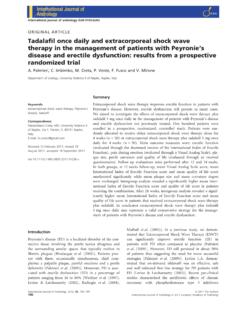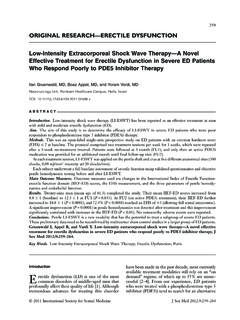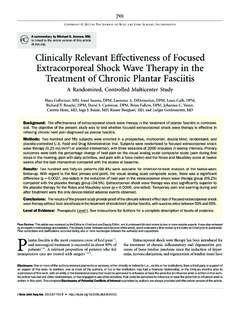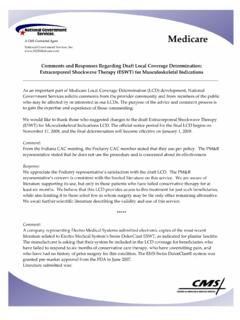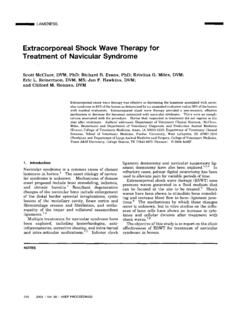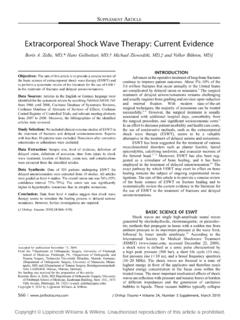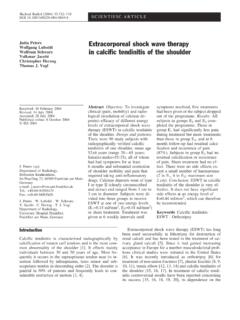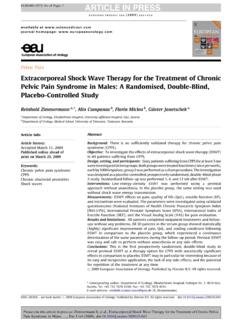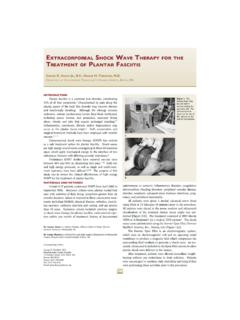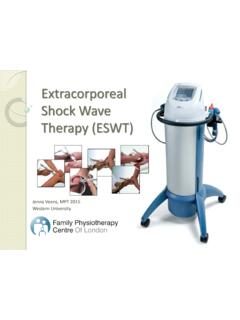Transcription of American Journal of Sports Medicine - ESWT
1 Journal of SportsDOI: 2006; 34; 733 Am. J. Sports Patrick Furia TendinopathyHigh-Energy extracorporeal Shock Wave therapy as a Treatment for Insertional The online version of this article can be found at: Published by: On behalf of: American Orthopaedic Society for Sports Medicine can be found at: American Journal of Sports MedicineAdditional services and information for Email Alerts: Subscriptions: : : #BIBLSAGE Journals Online and HighWire Press platforms): (this article cites 42 articles hosted on the Citations 2006 American Orthopaedic Society for Sports Medicine .
2 All rights reserved. Not for commercial use or unauthorized distribution. at Ebsco Host temp on September 6, 2007 from Disorders of the Achilles tendon are a frustrating cause ofposterior heel pain. Achilles tendon injuries occur frequentlyin runners and jumping athletes and are also common in thegeneral population, particularly in overweight persons. Theprecise causes and natural history of these injuries remainunknown. Intrinsic risk factors include hyperpronation, varus defor-mity of the forefoot, leg length discrepancy, and limitedmobility of the subtalar ,14,16,25,26,41 Extrinsic risk fac-tors include excessive mechanical overload and trainingerrors such as increased interval training, excessive hilltraining, and increased ,13,14,16,25,26,41 Other riskfactors include poor technique, fatigue, obesity, and ,13,14,16,25,26.
3 41 Maffulli et al20-22have popularized the term Achillestendinopathyto describe the triad of tendon pain, swelling,and impaired performance. From a functional perspective,it is helpful to classify Achilles tendinopathy as inser-tional, those which occur at the bone-tendon junction, ornoninsertional, those that occur more ,25,33 Insertional tendinopathy tends to occur in more activepersons, whereas noninsertional tendon injury tends tooccur in older, less athletic, and overweight ,25,33 Traditional nonoperative treatment of insertional Achillestendinopathy consists of rest, anti-inflammatory medica-tions, physical therapy modalities.
4 Heel lift orthosis, customorthosis, and ,23-26,30,40,41,43In the majorityof cases, nonoperative measures are ,23-26,30,40,41,43 Surgery for insertional Achilles tendinopathy is reservedfor chronic cases. Reports of surgical treatment can beHigh-Energy extracorporeal Shock WaveTherapy as a Treatment for InsertionalAchilles TendinopathyJohn Patrick Furia,* MDFrom SUN Orthopedics and Sports Medicine , Lewisburg, PennsylvaniaBackground:Results of high-energy extracorporeal shock wave therapy for the treatment of insertional Achilles tendinopathyare not determined.
5 It is unclear how local anesthesia alters the outcome of this : extracorporeal shock wave therapy is an effective treatment for insertional Achilles tendinopathy. Local anesthesiafield block adversely affects Design:Case control study; Level of evidence, :Thirty-five patients with chronic insertional Achilles tendinopathy were treated with 1 dose of high-energy extracor-poreal shock wave therapy (ESWT group; 3000 shocks ; mJ/mm2; total energy flux density, 604 mJ/mm2), and 33 weretreated with nonoperative therapy (control group).
6 All extracorporeal shock wave therapy procedures were performed using alocal anesthesia field block (LA subgroup, 12 patients) or a nonlocal anesthesia (NLA subgroup, 23 patients). Evaluation was byvisual analog score and by Roles and Maudsley :One month, 3 months, and 12 months after treatment, the mean visual analog score for the control and ESWT groupswere and (P<.001), and (P<.001), and and (P<.001), respectively. Twelve months after treatment, thenumber of patients with successful Roles and Maudsley scores was statistically greater in the ESWT group compared with thecontrol group (P>.)
7 0002), with 83% of ESWT group patients having a successful result, and the mean improvement in visualanalog score for the LA subgroup was significantly less than that in the NLA subgroup (F = vs F = , P<.001). Thepercentage of patients with successful Roles and Maudsley scores did not differ among the LA and NLA : extracorporeal shock wave therapy is an effective treatment for chronic insertional Achilles tendinopathy. Localfield block anesthesia may decrease the effectiveness of this :tendon injuries; Achilles tendinopathy; extracorporeal shock wave therapy (ESWT)733*Address correspondence to John Patrick Furia, MD, 900 Buffalo Road,Lewisburg, PA 17837 (e-mail: author has declared a potential conflict of interest: He is themedical director of the orthopedic division of American Kidney StoneManagement, American Journal of Sports Medicine , Vol.
8 34, No. 5 DOI: 2006 American Orthopaedic Society for Sports Medicine References 2, 3, 11, 13-15, 17, 20-23, 25, 30, 40-43. References 2, 3, 11, 13-15, 17, 20-23, 25, 30, 40-43. 2006 American Orthopaedic Society for Sports Medicine . All rights reserved. Not for commercial use or unauthorized distribution. at Ebsco Host temp on September 6, 2007 from 734 FuriaThe American Journal of Sports Medicinedifficult to interpret because of lack of adequate and generallyaccepted to all such surgical proce-dures is a resection of the inflamed retrocalcaneal bursa,excision of the prominent posterolateral bone, and debride-ment of the calcific and diseased tendon rates vary from series to ,11,21,47 Complicationssuch as delayed wound healing, infection, and tendon avul-sion can be ,21,47In one series.
9 25% of patientstreated surgically for insertional Achilles tendinopathywere unable to return to their preinjury level of another series, 2 of 14 patients treated surgi-cally did not obtain pain those patients whodid improve, the time until pain resolution averaged nearly12 shock wave therapy (ESWT) has beenused successfully since the late 1980s for the treatmentof various musculoskeletal disorders including plantar fasci-itis, shoulder calcific tendinitis, lateral epicondylitis, andnonunion of fractures of long bones.
10 There are now multi-ple, randomized, double-blinded, clinical trials that supportthe use of ESWT for plantar fasciitis, lateral epicondylitis,and calcific tendinitis of the ,10,27,28,35,38,39,45In con-trast, there are only a few reports that have investigated theefficacy of ESWT as a treatment for chronic ,31,32 None of these pilot studies focusedexclusively on the insertional form of Achilles all reports regarding ESWT have been ,12 One multicenter trial failed to show effectiveness of ESWT compared with placebo ESWT in patients with chroniclateral local anesthesia field block wasused in this authors have suggested that theapplication of local anesthesia before shock wave therapyreduces the efficiency of low-energy ESWT in patients withchronic plantar purpose of this study was to determine the efficacyof high-energy ESWT for the treatment of adults withchronic insertional Achilles tendinopathy and to determineif the use of a
